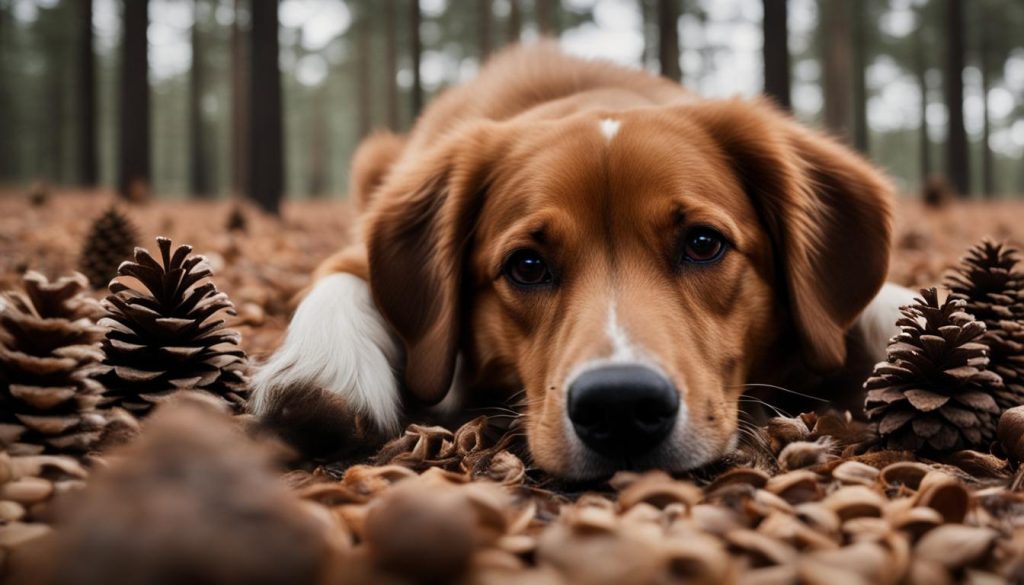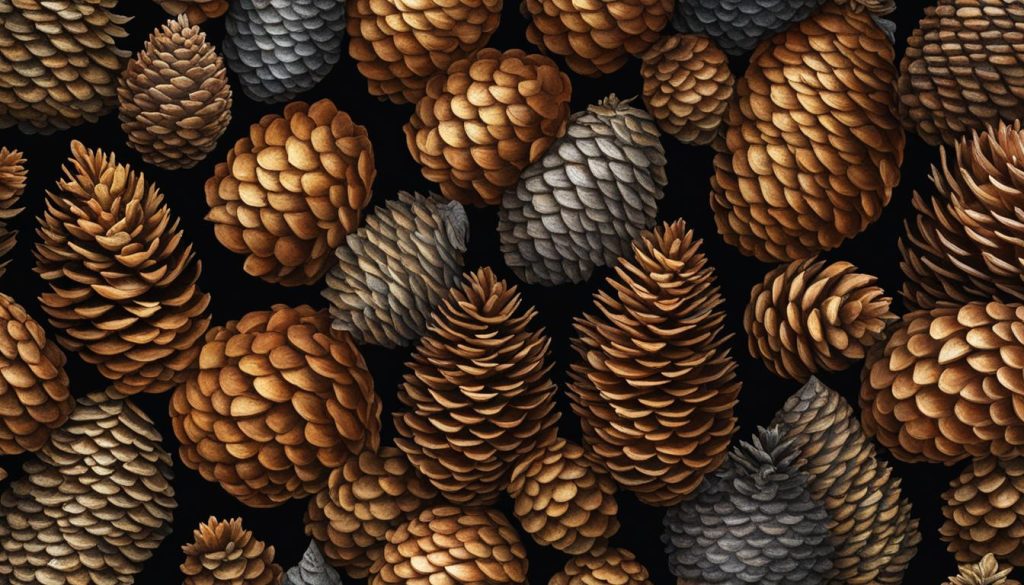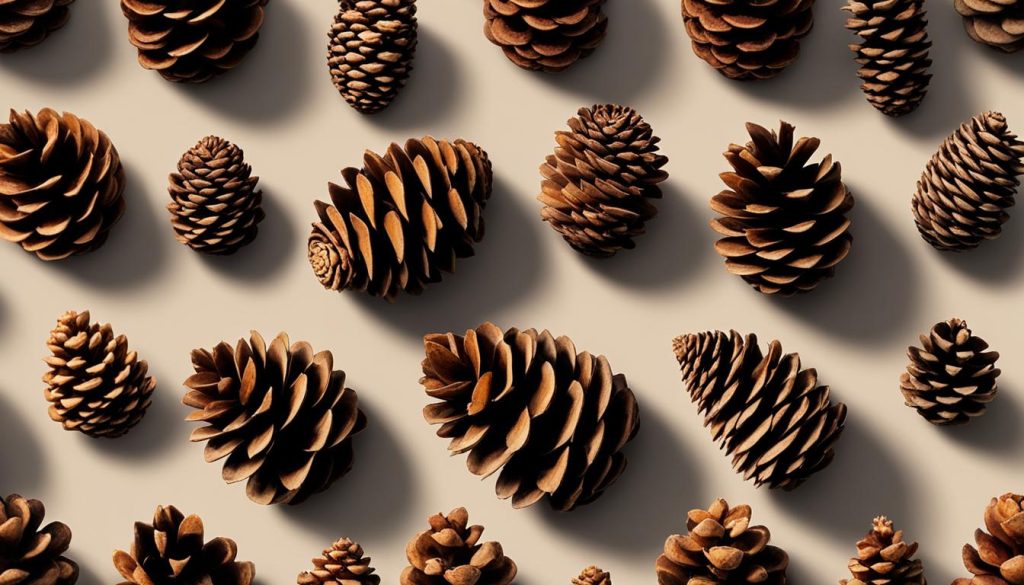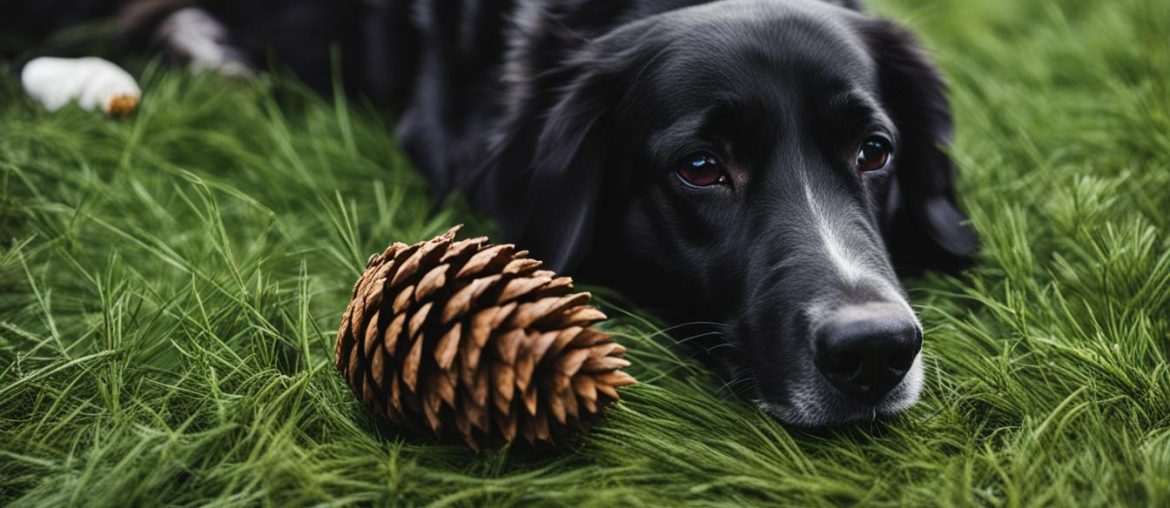Dogs are known for their curious nature, and it’s not uncommon for them to explore and even attempt to eat non-food items. One such item that may catch a dog’s attention is a pine cone. While it may seem harmless, it’s important to understand the potential risks and dangers associated with dogs consuming pine cones.
Pine cones can contain compounds that are toxic to dogs, such as tannins, which can cause digestive problems and irritation. Additionally, some pine cones may have seeds known as pine nuts, which can lead to a condition called pine mouth syndrome. This highlights the importance of preventing dogs from consuming pine cones to avoid potential health risks.
Key Takeaways:
- Consuming pine cones can be dangerous for dogs due to their potential toxicity.
- Pine cones can contain tannins, which can cause digestive problems and irritation.
- Pine nuts, found in some pine cones, can lead to pine mouth syndrome.
- Preventing dogs from eating pine cones is crucial for their well-being and health.
- Consulting a veterinarian is recommended if a dog has consumed a pine cone or shows signs of distress.
The Behavior of Dogs Eating Non-Food Substances

Dogs have a natural propensity to explore their surroundings and sometimes that includes chewing or eating non-food items. This behavior is especially common in puppies as they go through the teething phase and seek relief from discomfort. It is not uncommon to find your furry friend chewing on sticks, rocks, or even pine cones. But why do dogs eat non-food substances? Let’s explore some of the reasons behind this behavior.
Reasons Why Dogs Eat Non-Food Items:
- Exploration and Curiosity: Dogs use their mouths to investigate objects in their environment, and chewing or ingesting non-food items is a part of their exploration process.
- Teething: Puppies often chew on objects, including sticks and pine cones, to alleviate the discomfort caused by teething. Chewing provides relief for their sore gums.
- Boredom or Lack of Stimulation: Dogs may resort to chewing on non-food items out of boredom or a lack of mental and physical stimulation. This behavior can be seen as a way for them to entertain themselves.
While this behavior is relatively common, it is important to monitor your dog closely to prevent potential hazards. Chewing on sticks or pine cones can lead to splinters or choking if they swallow larger pieces. Additionally, ingesting non-food items can cause gastrointestinal issues, blockages, or damage to the teeth and mouth. If you notice excessive chewing or eating of non-food items, it is recommended to consult with your veterinarian for guidance and proper management.
Table: Potential Risks of Dogs Eating Non-Food Items
| Risks | Consequences |
|---|---|
| Choking Hazard | Swallowing large pieces of sticks or pine cones can cause blockages in the throat. |
| Gastrointestinal Issues | Ingesting non-food substances can lead to digestive problems, including upset stomach, vomiting, and diarrhea. |
| Mouth and Tooth Injuries | Biting down on hard objects can cause damage to the teeth and gums, leading to pain and potential dental issues. |
| Intestinal Blockage | If a dog swallows a large piece of a non-food item, it can get stuck in the intestines, requiring surgical intervention. |
As responsible dog owners, it is crucial to provide appropriate alternatives for your dog to chew on, such as durable chew toys or treats specifically designed for their needs. Proper training and redirection, along with regular exercise and mental stimulation, can help discourage the habit of eating non-food substances. By actively supervising your dog and addressing the underlying reasons for their behavior, you can ensure their safety and well-being.
Is It Safe for Dogs to Eat Pine Cones?

While dogs may be curious about pine cones and attempt to eat them, it is generally not safe for them to do so. Pine cones can contain compounds that are toxic to dogs, such as tannins. These compounds can cause digestive problems and irritation in dogs, leading to discomfort and potential health risks.
Dogs that consume pine cones may experience symptoms such as vomiting, diarrhea, abdominal pain, and decreased appetite. In severe cases, ingestion of pine cones can lead to blockages in the digestive system, requiring medical intervention. Therefore, it is crucial to prevent dogs from consuming pine cones to avoid these potential health hazards.
Furthermore, pine nuts, which are the seeds found within some types of pine cones, can also pose a risk to dogs. Pine nut ingestion can lead to a condition called pine mouth syndrome, which causes a bitter taste in the mouth and a loss of taste perception. This condition can last for several days or even weeks, making it uncomfortable for dogs to eat or drink.
Risks of Dogs Consuming Pine Cones:
- Possible toxicity due to the presence of tannins
- Digestive problems and irritation
- Vomiting, diarrhea, abdominal pain, and decreased appetite
- Potential blockages in the digestive system
- Pine mouth syndrome from consuming pine nuts
| Type of Risk | Description |
|---|---|
| Toxicity | Pine cones can contain toxic compounds like tannins, which can cause digestive problems and irritation. |
| Digestive Issues | Ingesting pine cones can lead to vomiting, diarrhea, abdominal pain, and decreased appetite in dogs. |
| Blockages | Pine cones may cause blockages in the digestive system, requiring medical intervention. |
| Pine Mouth Syndrome | Consuming pine nuts, which are found in some pine cones, can result in a loss of taste perception and a bitter taste in the mouth for dogs. |
To ensure the safety and well-being of your furry friend, it is important to prevent them from consuming pine cones. Keep a close eye on your dog while outdoors and promptly remove any pine cones from their reach. If you suspect that your dog has ingested a pine cone or is experiencing any symptoms of pine cone toxicity, it is advisable to consult your veterinarian for proper guidance and care.
Understanding the Anatomy of a Pine Cone

In order to fully comprehend the impact of pine cone consumption on dogs, it is important to have a thorough understanding of the anatomy of these intriguing natural structures. Pine cones are the reproductive organs of conifer trees, serving as a crucial part of their reproductive cycle. Let’s explore the different parts and functions of a pine cone.
Pine Cone Anatomy:
| Part | Function |
|---|---|
| Cone Scales | Protect the seeds and aid in seed dispersal. These scales can vary in size and shape depending on the species of conifer. |
| Bracts | Support the cone scales and connect them to the woody stem. They play a vital role in the structural integrity of the pine cone. |
| Seeds | Encased within the cone scales, the seeds are the reproductive units of the pine cone. They come in different types, each with their own characteristics and functions. |
The anatomy of a pine cone not only ensures the protection and dispersal of seeds but also contributes to the overall reproductive success and genetic diversity of conifer trees. It is through this intricate structure that new conifer trees are able to grow and thrive in various environments.
In Wrapping Up
By understanding the anatomy of a pine cone, we gain a deeper appreciation for the vital role these structures play in nature. While dogs may be curious about pine cones and attempt to consume them, it is important to consider the potential risks and dangers associated with their consumption. To ensure the well-being of our furry friends, it is best to prevent dogs from eating pine cones and to seek veterinary advice if any ingestion occurs.
Different Types of Pine Cone Seeds

Pine cones are fascinating reproductive structures of conifer trees that house various types of seeds. Understanding the different types of pine cone seeds can provide insights into their function and role in the natural world. Let’s explore the three main categories of pine cone seeds:
Ovulate Seeds
Ovulate seeds are the primary seeds found in pine cones. These seeds have the potential to develop into new trees when they are fertilized. Ovulate seeds play a crucial role in the reproduction and survival of conifer trees, ensuring the continuation of their species.
Bract Scale Seeds
Bract scale seeds are also present in pine cones. However, unlike ovulate seeds, these seeds do not grow into new trees. Instead, they provide some nutrition to support the growth and development of the tree. Bract scale seeds contribute to the overall health and vitality of conifer trees.
Winged Seeds
Winged seeds are another type of seed found in pine cones. These seeds are designed for wind dispersal, maximizing the chances of successful seed distribution. The wings attached to these seeds help them catch the wind and carry them away from the parent tree, allowing them to land in favorable environments for germination and growth.
The diversity of pine cone seeds ensures the survival and genetic diversity of conifer trees. Each type of seed plays a unique role in the life cycle of these magnificent trees, contributing to the rich ecosystems they inhabit.
Table: Comparison of Pine Cone Seed Types
| Seed Type | Description |
|---|---|
| Ovulate Seeds | The primary seeds that develop into new trees when fertilized. |
| Bract Scale Seeds | Provide nutrition for the tree’s growth but do not grow into new trees themselves. |
| Winged Seeds | Designed for wind dispersal, increasing the chances of seed distribution and germination in new locations. |
Toxicity of Pine Cone Seeds

It is important for dog owners to be aware of the potential toxicity of pine cone seeds. These seeds can contain toxic compounds such as resin acids and alkaloids, which can be harmful if ingested in large amounts. The presence of these compounds can cause gastrointestinal issues and other symptoms in both dogs and humans.
Symptoms of pine cone seed poisoning may include nausea, vomiting, stomach pain, and more. If your dog has ingested a significant amount of pine cone seeds or is exhibiting any of these symptoms, it is important to seek veterinary attention immediately. The veterinarian can provide appropriate treatment and guidance to ensure your dog’s health and well-being.
| Toxic Compounds | Symptoms |
|---|---|
| Resin acids | Nausea, vomiting, stomach pain |
| Alkaloids | Gastrointestinal issues, discomfort |
“The toxicity of pine cone seeds is a serious concern for dog owners. It is crucial to keep these seeds out of reach of our furry friends to prevent any potential health issues. If you suspect your dog has consumed pine cone seeds or is showing symptoms of poisoning, do not hesitate to contact your veterinarian for immediate assistance.”
Furthermore, it is important to note that not all pine cone seeds are toxic. Some pine cone species have edible seeds, such as certain types of pine nuts. However, it is essential to know the specific species of pine cone and consult with a veterinarian or professional before feeding them to your dog.
Reasons Why Dogs Eat Dirt
Dogs engaging in the behavior of eating dirt can have various underlying reasons. These can include mineral deficiencies, attention-seeking behavior, or simply finding the taste appealing. It is essential to understand these factors in order to address the behavior effectively.
In some cases, dogs may consume dirt to compensate for mineral deficiencies in their diet. Certain minerals, such as iron and zinc, are found in soil and may be lacking in their regular food. However, it is important to note that excessive dirt eating is not a reliable source of nutrition and can lead to other health issues.
Attention-seeking behavior can also play a role in dogs eating dirt. If a dog feels bored or neglected, they may resort to engaging in such behavior as a means of seeking attention from their owners. Providing adequate physical exercise, mental stimulation, and quality time with their human companions can help reduce this attention-seeking behavior.
| Reasons for Dogs Eating Dirt | Explanation |
|---|---|
| Mineral deficiencies in dogs | Dogs may consume dirt to compensate for lacking minerals in their regular diet, such as iron and zinc. |
| Attention-seeking behavior | If dogs feel bored or neglected, they may eat dirt as a means of seeking attention from their owners. |
| Taste and texture | Some dogs may simply find the taste or texture of dirt appealing, leading them to engage in this behavior. |
In addition to these reasons, some dogs may eat dirt simply because they find the taste or texture enjoyable. This can be particularly true for puppies, who may explore their environment using their mouth and develop a fondness for dirt. However, it is crucial to discourage this behavior to ensure their overall health and well-being.
By identifying the underlying reasons and addressing them effectively, dog owners can reduce or eliminate the behavior of dogs eating dirt. Ensuring a balanced and nutritious diet, providing ample physical and mental stimulation, and giving appropriate attention to their furry companions can help prevent this behavior and promote a healthier lifestyle.
Risks and Dangers of Dogs Eating Inedible Items
When dogs consume inedible items, it poses several risks to their health and well-being. Foreign body ingestion in dogs can lead to various complications and require veterinary intervention. Choking hazards are a significant concern, especially when dogs ingest objects such as stones, sticks, or trash. These items can become lodged in the esophagus or gastrointestinal tract, causing blockages that may require surgical removal.
Ingesting non-food substances can also result in gastrointestinal issues, such as vomiting, diarrhea, and abdominal pain. The digestive system of dogs is not designed to process these items, leading to discomfort and potential inflammation. Additionally, some inedible items may contain toxic substances that can further exacerbate health problems. It is crucial for dog owners to be vigilant and prevent their pets from accessing and consuming non-food objects to ensure their safety.
Here are some of the health issues associated with dogs eating non-food substances:
- Choking hazards and potential blockages in the gastrointestinal tract
- Gastrointestinal issues such as vomiting, diarrhea, and abdominal pain
- Exposure to toxic substances that can cause further health complications
To minimize the risks of dogs consuming inedible items, it is essential to provide proper supervision and training. By keeping a close eye on your dog and ensuring their environment is free from potential hazards, you can reduce the likelihood of foreign body ingestion. Additionally, providing appropriate chew toys and treats can redirect their chewing behavior towards safe and suitable objects.
| Risks and Dangers | Prevention Measures |
|---|---|
| Choking hazards and gastrointestinal blockages | Keep potential hazards out of reach and use a trash can with a locking lid |
| Gastrointestinal issues and discomfort | Monitor your dog’s behavior and provide a balanced and nutritious diet |
| Exposure to toxic substances | Avoid letting your dog access areas or objects with potentially harmful substances |
Tips to Prevent Dogs from Eating Dirt and Inedible Items
If your dog has a tendency to eat dirt or other inedible items, there are several strategies you can implement to discourage this behavior and ensure their safety:
- Supervise your dog closely during walks and outdoor playtime to prevent them from ingesting dirt or non-food objects. Keep them on a leash if necessary.
- Provide your dog with enough physical exercise and mental stimulation to prevent boredom, as excessive chewing or eating of non-food items may be a result of pent-up energy or lack of stimulation.
- Use positive reinforcement training techniques to teach your dog a “leave it” or “drop it” command. Consistently reward and praise them when they choose not to eat dirt or inedible items.
- Offer appropriate chew toys and treats to redirect your dog’s chewing behavior. This will help satisfy their natural instinct to chew without resorting to consuming harmful substances.
Additionally, consider implementing the following preventative measures:
- Use a trash can with a locking lid to prevent your dog from rummaging through and consuming trash or other hazardous materials.
- Keep your living space clean and organized to minimize the presence of small objects that could be tempting for your dog to ingest.
- If your dog is displaying signs of mineral deficiencies, consult with your veterinarian to ensure their diet is well-balanced and meets their nutritional needs.
By following these tips and taking proactive measures, you can successfully discourage your dog from eating dirt and inedible items, promoting their well-being and minimizing potential health risks.
The Importance of Veterinary Care and Monitoring
When it comes to dogs eating inedible items like dirt or non-food objects, veterinary care and monitoring play a crucial role in ensuring their well-being. If your dog regularly or excessively consumes these items, it is essential to seek veterinary advice to address any underlying health issues and prevent potential complications.
Veterinary care for dogs eating inedible items involves a comprehensive evaluation of your dog’s overall health. The veterinarian will assess their nutritional status, gastrointestinal function, and any potential underlying medical conditions that may contribute to their inappropriate eating behavior. They can provide guidance on prevention and management strategies tailored to your dog’s specific needs.
Monitoring your dog for signs of distress or illness is equally important. Keep a close eye on their behavior and look out for any abnormal symptoms such as vomiting, diarrhea, abdominal pain, or difficulty defecating. These signs may indicate a potential blockage or other health issues that require immediate veterinary attention.
| When to Seek Veterinary Help | Signs of Distress or Illness |
|---|---|
| If your dog consumes a large amount of inedible items | Vomiting |
| If your dog repeatedly engages in the behavior despite efforts to prevent it | Diarrhea |
| If your dog shows signs of discomfort or pain | Abdominal pain |
| If your dog has difficulty defecating | Straining to defecate |
Remember, addressing the issue promptly and seeking veterinary care can help prevent potential complications and ensure the well-being of your furry friend. So, if you notice any concerning behavior or distressing symptoms, don’t hesitate to reach out to your veterinarian for guidance and support.
Wrapping Up
After examining the behavior of dogs eating non-food substances, the safety of dogs consuming pine cones, and the risks associated with dogs eating inedible items, it is clear that precautions must be taken to prevent these behaviors.
While it may be tempting to allow our dogs to explore and interact with their environment freely, it is important to prioritize their safety and well-being. Dogs should not be allowed to eat pine cones or other non-food items as they can contain toxic compounds and lead to health complications.
To prevent dogs from eating inedible items, such as dirt, stones, sticks, and trash, it is essential to provide proper supervision, training, and appropriate alternatives. By closely monitoring our dogs, providing mental and physical stimulation, and offering safe chew toys and treats, we can discourage them from engaging in this potentially harmful behavior.
If the behavior persists or if any signs of distress or illness are observed, it is crucial to seek veterinary care. A veterinarian can assess the overall health of our dogs, address any underlying medical issues, and provide guidance on prevention and management.
FAQ
Can dogs safely eat pine cones?
No, it is generally not safe for dogs to eat pine cones. Pine cones can contain toxic compounds that can cause digestive problems and irritation in dogs.
Why do dogs eat non-food items like sticks and pine cones?
Dogs, especially puppies, may have a tendency to chew on non-food items out of curiosity, teething, or as a form of exploration and play.
What are the risks of dogs consuming pine cones?
Dogs eating pine cones can lead to potential health risks such as digestive problems, irritation, and the possibility of pine nut poisoning.
What is the anatomy of a pine cone?
A pine cone consists of cone scales, bracts, and seeds. The scales protect the seeds, while bracts provide support and connect them to the woody stem.
What are the different types of pine cone seeds?
Pine cone seeds can be categorized as ovulate seeds, bract scale seeds, and winged seeds, each serving different functions in seed dispersal and tree growth.
Are pine cone seeds toxic to dogs?
Some species of pine cone seeds can be toxic to dogs and humans. Ingesting large amounts of toxic compounds found in pine cone seeds can cause gastrointestinal issues and other symptoms.
Why do dogs eat dirt?
Dogs may eat dirt for various reasons, including mineral deficiencies, attention-seeking behavior, or simply because they find it appealing in terms of taste or texture.
What are the risks of dogs eating inedible items?
Dogs consuming inedible items like dirt and non-food objects can pose various health risks including choking hazards, gastrointestinal issues, and the need for surgery to remove foreign bodies.
How can I prevent my dog from eating dirt and inedible items?
Strategies to discourage dogs from eating dirt and inappropriate objects include using a garbage can with a locking lid, providing adequate exercise and mental stimulation, and supervising them closely.
When should I seek veterinary care for my dog’s eating habits?
If your dog regularly or excessively eats dirt or inedible items, it is important to seek veterinary advice. A veterinarian can evaluate your dog’s health and provide guidance on prevention and management.
Can dogs safely eat pine cones?
No, it is generally not safe for dogs to eat pine cones. Instead, provide them with safe alternatives such as appropriate chew toys and treats.






